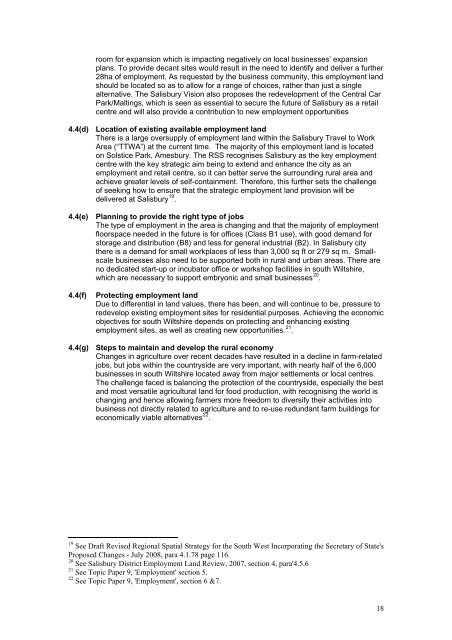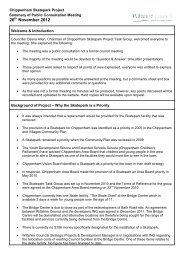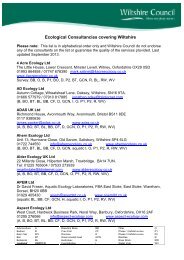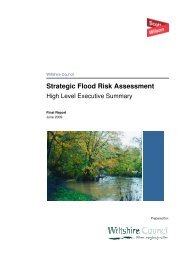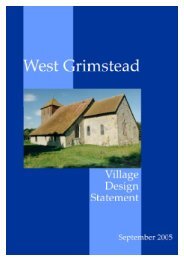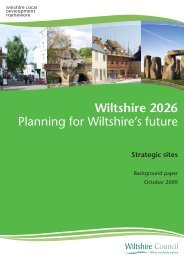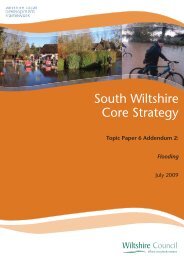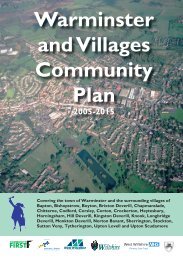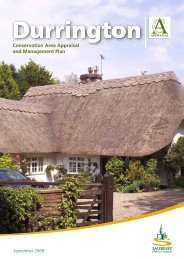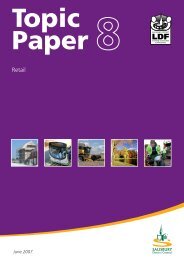South Wiltshire Core Strategy - Wiltshire Council
South Wiltshire Core Strategy - Wiltshire Council
South Wiltshire Core Strategy - Wiltshire Council
Create successful ePaper yourself
Turn your PDF publications into a flip-book with our unique Google optimized e-Paper software.
oom for expansion which is impacting negatively on local businesses’ expansion<br />
plans. To provide decant sites would result in the need to identify and deliver a further<br />
28ha of employment. As requested by the business community, this employment land<br />
should be located so as to allow for a range of choices, rather than just a single<br />
alternative. The Salisbury Vision also proposes the redevelopment of the Central Car<br />
Park/Maltings, which is seen as essential to secure the future of Salisbury as a retail<br />
centre and will also provide a contribution to new employment opportunities<br />
4.4(d) Location of existing available employment land<br />
There is a large oversupply of employment land within the Salisbury Travel to Work<br />
Area (“TTWA”) at the current time. The majority of this employment land is located<br />
on Solstice Park, Amesbury. The RSS recognises Salisbury as the key employment<br />
centre with the key strategic aim being to extend and enhance the city as an<br />
employment and retail centre, so it can better serve the surrounding rural area and<br />
achieve greater levels of self-containment. Therefore, this further sets the challenge<br />
of seeking how to ensure that the strategic employment land provision will be<br />
delivered at Salisbury 19 .<br />
4.4(e) Planning to provide the right type of jobs<br />
The type of employment in the area is changing and that the majority of employment<br />
floorspace needed in the future is for offices (Class B1 use), with good demand for<br />
storage and distribution (B8) and less for general industrial (B2). In Salisbury city<br />
there is a demand for small workplaces of less than 3,000 sq ft or 279 sq m. Smallscale<br />
businesses also need to be supported both in rural and urban areas. There are<br />
no dedicated start-up or incubator office or workshop facilities in south <strong>Wiltshire</strong>,<br />
which are necessary to support embryonic and small businesses 20 .<br />
4.4(f)<br />
Protecting employment land<br />
Due to differential in land values, there has been, and will continue to be, pressure to<br />
redevelop existing employment sites for residential purposes. Achieving the economic<br />
objectives for south <strong>Wiltshire</strong> depends on protecting and enhancing existing<br />
employment sites, as well as creating new opportunities. 21 .<br />
4.4(g) Steps to maintain and develop the rural economy<br />
Changes in agriculture over recent decades have resulted in a decline in farm-related<br />
jobs, but jobs within the countryside are very important, with nearly half of the 6,000<br />
businesses in south <strong>Wiltshire</strong> located away from major settlements or local centres.<br />
The challenge faced is balancing the protection of the countryside, especially the best<br />
and most versatile agricultural land for food production, with recognising the world is<br />
changing and hence allowing farmers more freedom to diversify their activities into<br />
business not directly related to agriculture and to re-use redundant farm buildings for<br />
economically viable alternatives 22 .<br />
19 See Draft Revised Regional Spatial <strong>Strategy</strong> for the <strong>South</strong> West Incorporating the Secretary of State's<br />
Proposed Changes - July 2008, para 4.1.78 page 116.<br />
20 See Salisbury District Employment Land Review, 2007, section 4, para'4.5.6<br />
21 See Topic Paper 9, 'Employment' section 5.<br />
22 See Topic Paper 9, 'Employment', section 6 &7.<br />
18


